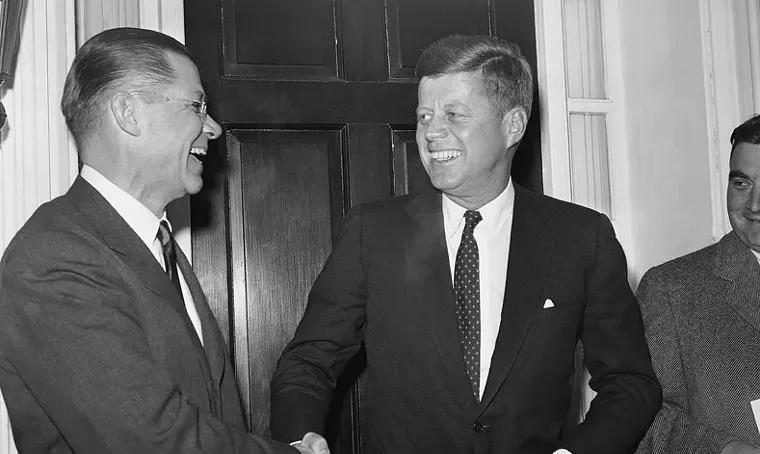Thing to Do: Read McNamara at War A New History by Philip and William Taubman
In 1995 when Robert McNamara published his memoir In Retrospect: The Tragedy and Lessons of Vietnam, he made an admission that stunned and sent shockwaves through friends and foes alike: “We were wrong,” he wrote. “Terribly wrong.”
That mea culpa came from not a scholarly observer, but the Secretary of Defense for Presidents John Kennedy and Lyndon Johnson. A man who purposefully pushed, planned, expanded an executed U.S. involvement in the war, even when he knew it was unwinnable.
That made him to many the real “villain” of the conflict, with the blood of tens of thousands of American and Vietnamese casualties if not on his hands, then at least smeared on his palm.
Using many new or never-before-released archives and information, history/political authors (and brothers) Philip and William Taubman, present the most complete and definitive look at the complicated life and legacy of the man and his work in McNamara at War: A New History (512 pp., $39.99. W.W. Norton).
Growing up with an aloof, older father and overbearing mother, Robert McNamara adopted many of the personality traits that he would carry through his life: seriousness, sobriety, planning, efficiency logic, data processing, schedules set and met, and an unbeatable work ethic.
He was the smartest guy in the room, and he knew it (critics would carp at the size of his ego). It served him well in roles at the Harvard Business School, U.S. Air Force Office of Statistical Control (where he planned air attacks during World War II), and Ford Motor Company, where he rose to President.
President-elect Kennedy and McNamara outside JFK’s Georgetown home where Kennedy announced McNamara’s appointment as Secretary of Defense, December 12, 1960.
AP Photo/John Rous
President-elect John Kennedy tapped him to be Secretary of Defense for the administration, but it was a role McNamara wasn’t convinced he could handle. He eventually took the job, becoming one of the major faces of Kennedy’s New Frontier. Even if that face, with its slicked back hair and granny glasses, seemed like it had come from an earlier era.
One of the book’s biggest new revelations is the closeness that McNamara had with First Lady Jackie Kennedy. Some whispered too close. Extremely fond of him both personally and his approach to life (perhaps the complete opposite of her continually cheating husband), she effusively wrote he and his wife many missives. But mostly him.
Greeting South Vietnamese children in the Mekong River Delta village of Hoa Hao, March 9, 1964.
AP Photo
Early in the administration, she even brought out his more playful side, as she danced the then-popular dance craze the Twist with the surprisingly agile McNamara at a White House function. After Kennedy’s assassination, she even asked him to be some sort of father figure to little JFK, Jr.
As the Taubmans note, the pair spent many an evening for years over dinner or in deep discussion quoting poetry in Kennedy’s homes—always when McNamara’s wife Margy was “traveling.” And they shared many phone calls and missives. As the Taubmans show with Kennedy’s archives (one of the new document troves for this book, along with the diaries of a McNamara aide). Though they stop short of intimating how intimate the relationship ever truly was.
President Johnson and McNamara, showing their fatigue on February 7, 1968, just days after beginning the Tet Offensive.
LBJ Library photo by Yoichi Okamoto
McNamara and John Kennedy shared a warm and convivial relationship of mutual respect. And both believed that South Vietnam should not fall to the Communist North. So more and more “advisors” were sent over. And the Taubmans note that both men pondered pulling out prior to November 22, 1963.
McNamara stayed on for the Johnson administration, and initially they had great respect for each other. But they both were alpha, and their relationship morphed in short years one that was uncomfortable, uneasy, and fraught.
By the time that the U.S. sent actual combat troops overseas in 1965, the Secretary already had doubts that American’s objective could be reached, especially as South Vietnam failed to step up in their own defense and suffered their own internal political turmoil. Hence, more U.S. troops arrived. And more.
“The Vietnam War” eventually became known in circles as “McNamara’s War.” He would suggest ways to Johnson how to pull out but never forced the issue. Many ideas were floated. At one point, McNamara said that with $2 billion (or $19.3 billion today) he could build a physical and impenetrable wall between North and South Vietnam.
And then his own opinions would change. He would be met with anti-war protestors more and more. The book’s cover is a striking image of McNamara looking down from his White House office at one such protest that drew more than 20,000 people.
The war even came directly to his home, as his children questioned their father about what he was doing. His teenaged son even hanging an upside-down American flag in his bedroom.
So, in February 1968, when McNamara’s views were in open conflict with Johnson’s, who still wanted to push to win, he was (Fired? Reassigned? Moved?) to become President of the World Bank. And McNamara’s war would become Johnson’s War and then Nixon’s war for seven more years at the cost of tens of thousands of more young American lives.
In conferences, speeches, articles, and even a documentary (The Fog of War), McNamara spent his last decades alternately defending and defying his role—perceived and real—in the Vietnam War. Personally, he had a healthy slate of relationships with women (and marrying again) even well into his 80s. Though his frayed connection to his children never wholly healed.
He died in 2009 at the age of 93. And even in 2025 the mere mention of his name is enough to set off now-aged former hippies, war protestors, activists, and scholars. But in this case, McNamara at War: A New History actually lives up to the promise of its title.

Reign Bowers is an outdoor enthusiast, adventure seeker, and storyteller passionate about exploring nature’s wonders. As the creator of SuperheroineLinks.com, Reign shares inspiring stories, practical tips, and expert insights to empower others—especially women—to embrace the great outdoors with confidence.









Post Comment